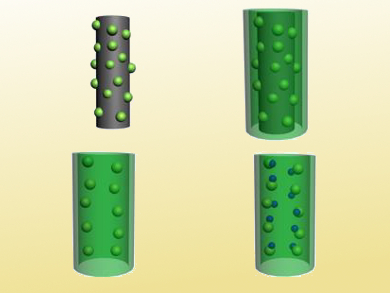Heterogeneous catalysts with a yolk/shell nanostructure can be seen as ideal nanoreactors for catalytic reactions due to their ability to protect active sites and enhance reactivity. The structural design and synthesis of such nanoreactors have been the subject of much recent research.
Weiguo Song and colleagues, Chinese Academy of Sciences, Beijing, designed an efficient and controllable route to prepare a magnetic tubular nanoreactor comprising a mesoporous SiO2 shell with iron-noble metal nanoparticles inside (pictured).
They first anchored Fe3O4 nanoparticles to multiwalled carbon nanotubes, coated the tubes with a mesoporous SiO2 shell, and then removed the carbon by calcination in air. The researchers then loaded the nanoparticles inside the silica shell tubes using a galvanic replacement reaction between iron and noble metal ions (Pd, Pt or Au ions). The loading amount of noble metal nanoparticles can be tuned easily.
One of the synthesized catalysts, a Pd-Fe@meso-SiO2 tubular nanoreactor, exhibited much better activity and stability than commercial Pd/C for styrene hydrogenation. This synthesis method could be extended to prepare other magnetic tubular nanoreactors with excellent catalytic performance.
- Preparation of Magnetic Tubular Shape Nanoreactors for Highly Efficient Catalysis,
Wei-Guo Song, Shuliang Yang, Li Peng, Changyan Cao, Fang Wei, Jian Liu, Ya-Nan Zhu, Chang Liu, Xiaoshi Wang,
Chem. Asian J. 2016.
DOI: 10.1002/asia.201600454




